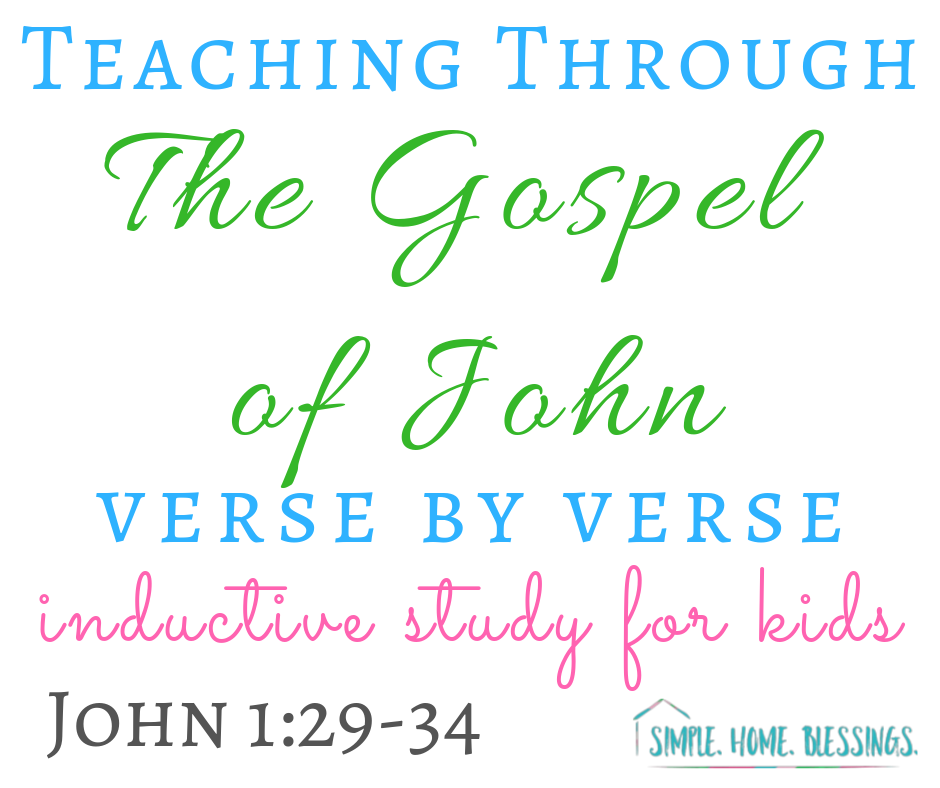
We are back after a short hiatus for varied adventures around the country involving more rental vehicles than I care to mention. And what a refreshing passage to come back to!! We were even able to come up with a song to help us remember the testimony of John!
A note about the formatting for this and future posts: I previously created a conversational outline of the teaching time we have for each day. It looked just the way I wanted it to look. Then I went away and my post editor changed; and I cannot figure out how to edit it the way you (and I) are used to seeing it. Please bear with the change. It will hopefully be something simple I can figure out soon.
Day One – The Lamb of God
We started our first day back with a quick review of all we have learned in the first part of John chapter 1. It was good for getting the cobwebs out and preparing the context for our new passage. As we reviewed I made sure to emphasize our understanding of who John (not the author) is: a witness sent from God to testify about the Light. We talked about what he had already said about Jesus and why his arms have arrows that point slightly up and forward and back. As we reviewed this, I drew our representation of John on our chalkboard table. We labeled him, just for the sake of seeing his name on him.
We also talked about how some people had been sent to John in Bethany beyond the Jordan from Jerusalem. They had some questions for him. We talked about those questions.
And then we read our verse for the day.
The next day he saw Jesus coming to him and said, “Behold, the Lamb of God who takes away the sin of the world!”
Note: everytime we spoke the words of John in this verse, we made a megaphone with our hands and used our best John voices. It got a little loud, but it was memorable!
Here’s our conversation:
The verse says, “the next day” what had happened on the day before? (the men came and asked John who he was. Was he Elijah, or the Prophet, or Jesus?!)
They asked him why he was doing something specific. What was that thing he was doing in the water? (baptizing!)
Had they figured out exactly who John was? (NO!!)
That’s right! They were still a bit confused as to who he was and what he was doing. So the very next day some of these people who asked these questions may have been there. Who came walking up to John? (Jesus!!)
YES!! And what did John say? (Behold the Lamb of God who takes away the sin of the world.) I took the time to write this out word for word.
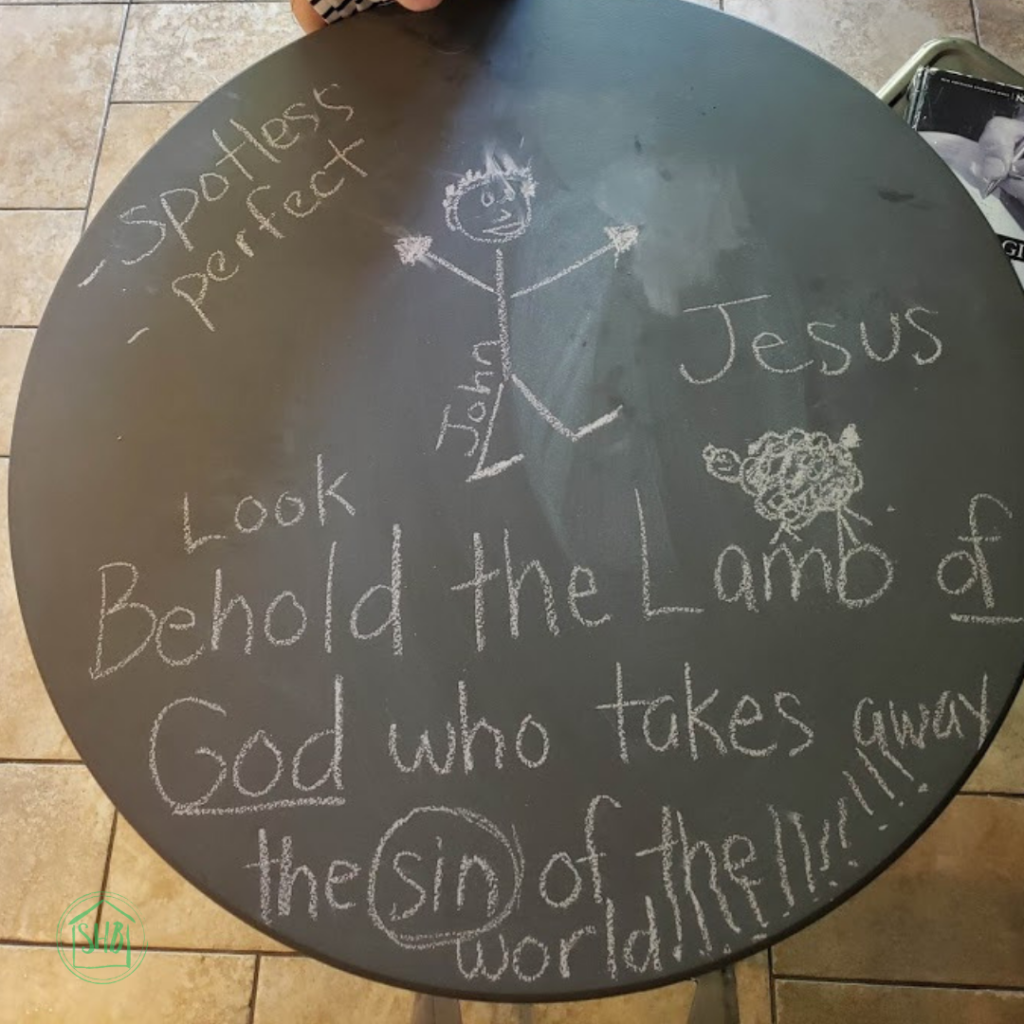
What does “behold” mean? (thinking…thinking) When you see something important that you want me to see, how do you draw my attention to it? (we say, “LOOK!”)
That’s right! And that is exactly what “behold” means: Look! Who does John see that he wants to draw attention to? (Jesus!!) (I wrote Jesus in front of John. )
We know it is Jesus who is coming to John because the verse tells us. Then WHY does John call him a Lamb? Is Jesus an animal? (No!)
Is John comparing Jesus to a Lamb? (Yes!!) (I drew a lamb above the word lamb in the verse)
Why would John compare Jesus to a Lamb? Let’s talk about it a little bit.
In the Old Testament, people sinned just like we all do. And God told His people that when they sinned, they needed to kill (sacrifice) a lamb to offer it to Him. (Why?) Because God commanded them to it. They needed a covering for their sin and this is what God chose.
But God had a standard for the lambs that His people would sacrifice to take away their sins. They had to be perfect and spotless. (I wrote perfect and spotless on the table)
Now, how often do we sin? Once a day? Twice a day? (a LOT!) Yes! God’s people sinned a lot too. And that meant that they needed to sacrifice a LOT of lambs. This was a problem, too, because it only took care of some of the sins the people committed. And then the people would sin again, needing another lamb – it couldn’t take away sin forever.
But God made promises to His people about a Person He would send who would come and take away the sin of His people FOREVER! Here in this passage, on that day, John saw Him! Who was He? (JESUS!!) And what did he say when he saw Him? (Behold, the Lamb of God who takes away the sin of the world!)
If you were John and you knew there would be a Lamb from God who would take away the sin of the world and then you SAW Him, how would you feel? (excited!) So, let’s look at this sentence and decide what kind of end mark it needs. (it needs an exclamation point…a LOT of them!)
Day Two – You Don’t Know Him?
To begin our day, I started by drawing our picture of John. I reviewed what we know about John from our previous verses as we talked about why he is drawn the way he is. The emphasis on each of these review sessions is:
- What is John’s job? (to testify about the Light)
- Who is John going to talk about? (Jesus)
- What does John say about Jesus? (“The One who comes after me has a higher rank than I for He existed before me.” And the new statement: “Behold the Lamb of God who takes away the sin of the world.”)
Today we read a couple verses to get us going, verses 29-30:
The next day he saw Jesus coming to him and said “Behold, the Lamb of God who takes away the sin of the world! This is He on behalf of whom I said, ‘After me comes a Man who has a higher rank than I, for He existed before me.
Here’s our conversation:
Hey, we know that verse! Don’t we! We already know who John is talking about here. (Yes!) That is why we have drawn John this way, right? (Yes!)
Now, there is something very strange in the next verse. Let’s look at it, verse 31:
I did not recognize Him, but so that He might be manifested to Israel, I came baptizing in water.
This verse is very strange, indeed! Let’s talk about it. What does it mean to recognize someone or something? (to see someone you know)
Good! I like that definition! (I wrote it down under the word recognize)
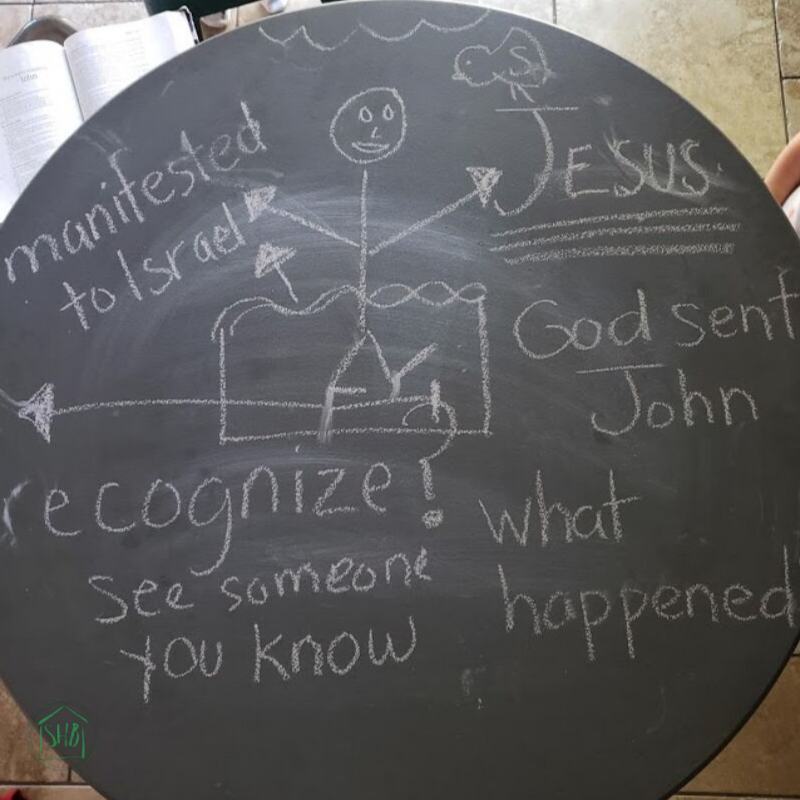
How did he not know Jesus?
What is going on here?!? How is it that John, the one who has been sent from God to testify about the Light doesn’t even recognize Him? (maybe he was disguised?)
Well, sort of. John only had heard from the prophets about the One who would come. The prophecies didn’t give His exact name or even a picture of him. They told about Him. So John woudn’t have known for sure that Jesus was the Messiah.
What happened?!? What did John see to let him know that Jesus was the One the Old Testament had promised would come? Let’s read on to hear about it, verses 32-33
John testified saying, “I have seen the Spirit descending as a dove out of heaven, and He remained upon Him. I did not recognize Him, but He who sent me to baptize in water said to me, ‘He upon whom you see the Spirit descending and remaining upon Him, this is the One who baptizes in the Holy Spirit.’
This is quite an event in John’s testimony! What does he say happened first? (He saw the Holy Spirit descending as a dove out of heaven) Have you ever seen the Holy Spirit? Can you see God? (No!)
Well, John testifies that he saw the Holy Spirit and He came down out of heaven as a dove! What does he say happened after the dove came down? (He remained on Him)
Now John goes on to testify saying he did not recognize Jesus at first, but He says that someone told him something about this Person. Let’s read that again (“He who sent me…”)
Who sent John? Do you remember, “there was a man sent from God, whose name was John…”? (We have a song we know with this verse, so we can sing it at almost any moment. This is what I started singing and the students came in chorus immediately) (God sent John!)
What did God tell John would happen? Let’s read the verse again. (“He upon whom you see the Spirit descending and remaining upon Him…”)
Here, we have something extraordinary – this man, Jesus who comes to John has God testifying to John about Him and saying that the Holy Spirit will come down from heaven and rest on Him.
NOTE: The next two questions are from our catechism work. I set the questions and answers to tunes the kids know. I can literally start singing the question at random times and they will join in and sing the answer. I cannot tell you how valuable a practice this has been in getting basic theological information into the hearts of my kids.
In how many persons does this one God exist? (God exists in three persons.) Who are they? (The Father, the Son and the Holy Spirit!)
Right here in this verse we have something HUGE happening! All THREE persons of this ONE GOD are here!!! This testimony of John is getting exciting!! Tomorrow we will learn more about it.
Day Three – The Gospels
Because the event described by the writer of John is so important, I wanted to make sure my students understand how world changing this moment was. I decided to use our third day in this passage to work with the Bible study tool of cross-referencing.
We began our conversation by talking about the books of the New Testament. Again, we have a song we memorized this past year that helps us not only to remember the books of the New Testament, but also what type of book they are. I began by singing, “Matthew, Mark, Luke and John…” My student chimed in, “These are the gospels, one by one!”
Then I gave a very simple definiton of the gospels. The gospels are the good news about Jesus. They are all testimonies about Jesus. If I asked each of you to tell me about a story you both read, you would tell me two different versions of the same story. You would tell me the things you thought were important and you might not think the same things were important. Your stories would be similar, but they would not be exactly the same.
The gospels are like this. They are all stories about the life, death, and resurrection of Jesus; but they are told by four different men.
Today, we are going to look at what each of these men had to say about this HUGE event that happened when John saw Jesus.
For reference, we only looked at the very specific verses which describe the events of the baptism of Jesus. They are: Luke 3:21-22; Matthew 3:13-17; and Mark 1:9-11. In each instance, we highlighted the things we saw repeatedly. This, in inductive study, would be similar to making a chart of comparison. Instead of writing anything down, we simply read through the passages and discussed the similarities.
Once we were done reading all three cross-references, I asked my students if they thought they would be able to tell me the story. We delighted in the retelling of the stories! It is so good when, because of diligent study, one can tell the good news of Jesus! I would love to share both of the stories my students told, but I only had one volunteer.
Day Four – the Testimony of John
It has been a long time since we were at the very beginning of this passage! But at the very beginning of John 1:19, John the author says, “This is the testimony of John.” For today’s lesson, we focused on the big picture of what John’s testimony was.
I started by asking my students to give me instructions of how to draw John. I followed their instructions explicitly. Once he was drawn, we started our conversation.
What was John’s job? (to be a witness, to testify about the light) Yes! (I wrote “job: testify about the light” on our chalkboard table)
And what did he say when the people came to him from Jerusalem and asked him who he was? What was his testimony? (he was not the Christ, not Elijah, and not the Prophet, he a voice crying, “Make straight the way of the LORD!”) (I wrote Testimony on the table)
But does John really want to talk about himself? (NO!) Who does he want to talk about (Jesus!) Yes!
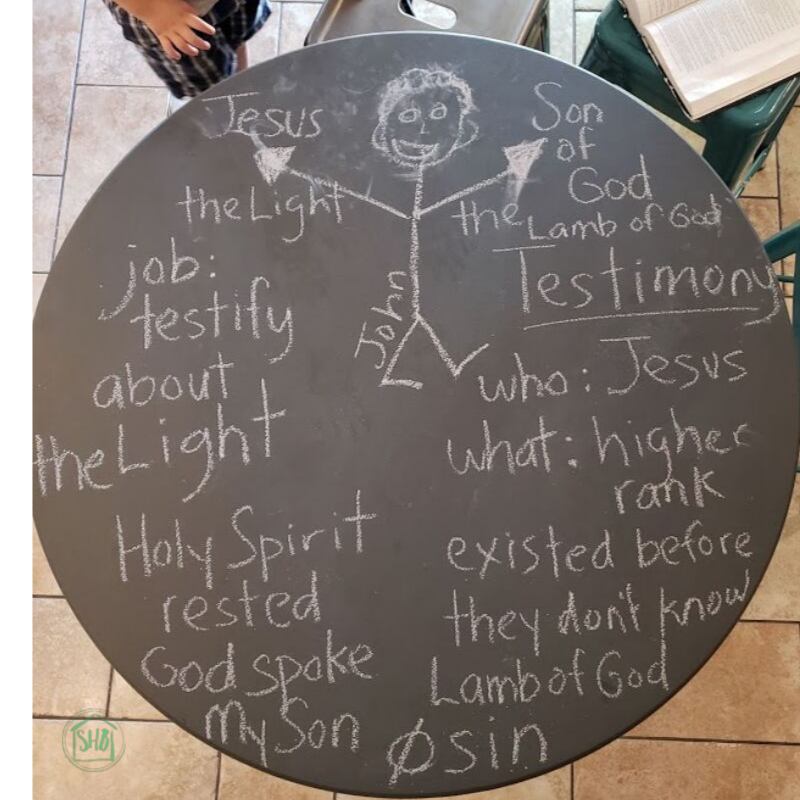
Do you remember some of the things he said about Jesus? (he who comes after me has a higher rank than I because he came before me, they don’t know him; Behold the Lamb of God who takes away the sin of the world, the Holy Spirit rested on Him; God spoke from heaven, calling Him His Son in whom he was pleased) (I simply wrote down in list form the things they remembered about John and Jesus. It is thrilling to see just how much they remember!)
At the end of the day, when John has completed his testimony about Jesus, he has one more thing to say. Let’s look at it in verse 34:
I myself have seen, and have testified that this is the Son of God.
It doesn’t get more clear than that. At the end of all the questions, John concludes his testimony by saying Jesus is the Son of God. Do you think we can come up with a song to help us remember what John has to say about Jesus?
We worked on a song using the tune of “This Little Light of Mine.” It is pretty catchy. It is hard to hear the beginning of it because I tripped up and started to sing the original words to the tune. But here are the lyrics for our version:
John said Jesus was the Light of the world.
John said Jesus was the Lamb of God.
John said Jesus was the Son of God.
Let Him shine, let Him shine, let Him shine.
Some Concluding Thoughts
I feel I always have to say this at the end of each lesson: These ideas are simple! I don’t purport to tackle all the difficulties of theology with my kids. We are simply working on the earliest parts of Inductive study – observation and interpretation. My students are still in the Grammar stage of their education. That means they need a lot of memorizing, a lot of naming, and a good dose of storytelling. They also need help noticing the details and finding a means of expressing what is in their thoughts.
For those of you who have dipped a toe into Inductive Study yourselves, you will likely recognize the Grammar stage of learning correlates very well to the observation step of Bible study. In these examples of our Bible time, I have simply attempted to help you begin the conversations we have (through diligent study) internalized. Sometimes we forget just how far we have come in our learning. A good reminder is to have to teach it to a novice.
Additionally, I cannot tell you how valuable our memorization of the catechism (in song form) and other songs has been for us. We spend our days singing and making melody in our hearts as a result. Memorizing songs about God has been the best thing we have done in our homeschool!
May God bless you and your children in the study of His precious Word!





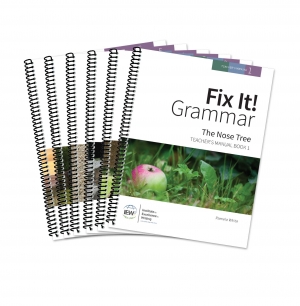
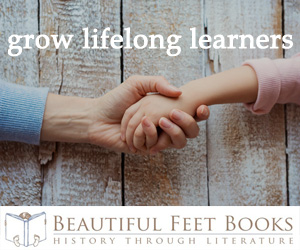
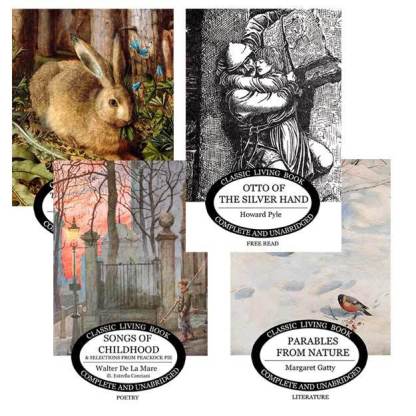
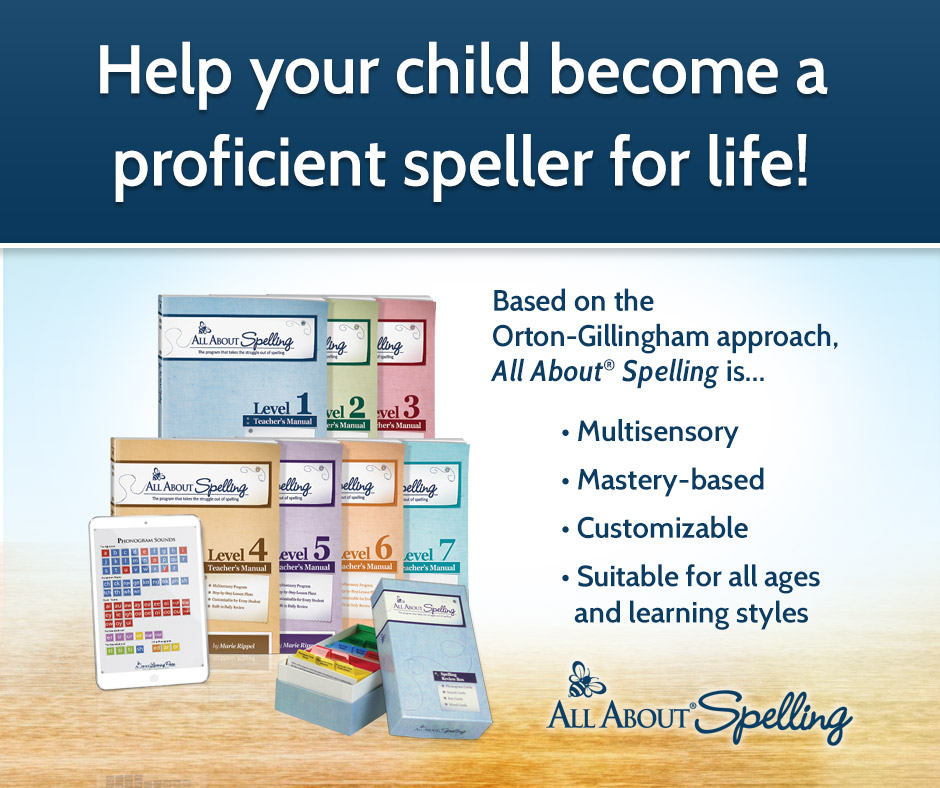






This Post Has One Comment
Lovely! It’s so wonderful to include religious texts in your children’s education. We love trying to help our children understand the basic concepts of the word of God, and the more simple, the more enjoyable. Thanks for the easy step by step guide! 🙂